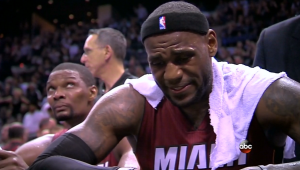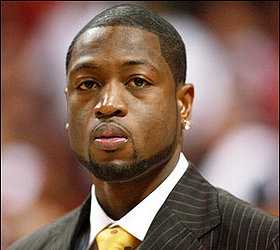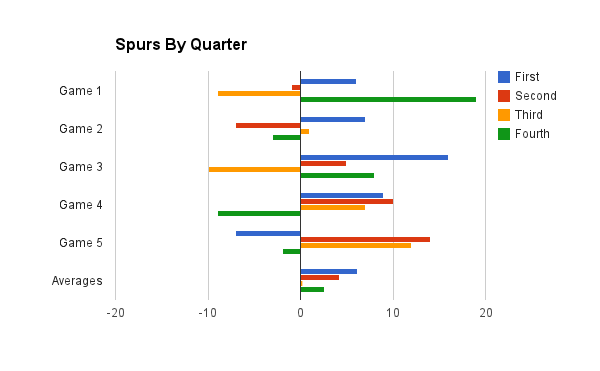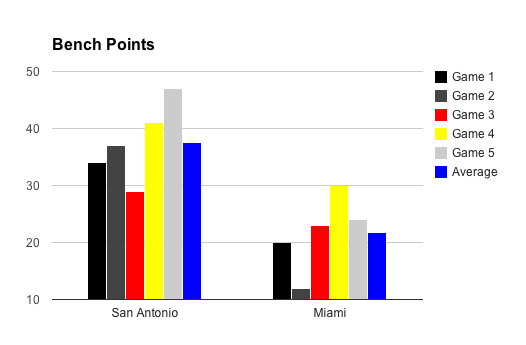 LeBron James and the Miami Heat were quickly dispatched by the San Antonio Spurs in five games in this year’s NBA Finals, so James is a pretty convenient scapegoat for his team’s failure to win a third straight championship. But LeBron is about as far from blame here as you can get.
LeBron James and the Miami Heat were quickly dispatched by the San Antonio Spurs in five games in this year’s NBA Finals, so James is a pretty convenient scapegoat for his team’s failure to win a third straight championship. But LeBron is about as far from blame here as you can get.
Just read James’ per-game averages in The Finals: 57.1 percent shooting from the field, 51.9 percent from the arc and 28.2 points, 7.8 rebounds and 4.0 assists per game. His postseason PER of 31.1 is his best mark since the 2008-2009 season. Everything else went horribly wrong, including his best supporting player, the defense, the slow starts and the overwhelmed bench.
The 2014 Finals will be remembered for this great Spurs team first. But we’ll also remember how Dwyane Wade’s stock took a precipitous tumble. The athleticism wasn’t there. His shooting touch and aggressiveness weren’t, either. Based on how Miami performed while he was on the floor, Wade could be considered a liability.
| Wade | FG % | Points | Assists | Rebounds | Plus/Minus |
| Game 1 | 44.4 | 19 | 2 | 3 | -18 |
| Game 2 | 55.6 | 14 | 4 | 7 | -8 |
| Game 3 | 66.7 | 22 | 2 | 4 | -9 |
| Game 4 | 23.1 | 10 | 4 | 2 | -9 |
| Game 5 | 33.3 | 11 | 1 | 3 | -10 |
| Averages | 44.62 | 15.2 | 2.6 | 3.8 | -10.8 |
 Wade shot 50 percent from the field in the postseason, better than his career playoff mark of 47.8 percent. But either he was too tired, injured or just came up really short in this series.
Wade shot 50 percent from the field in the postseason, better than his career playoff mark of 47.8 percent. But either he was too tired, injured or just came up really short in this series.
All the numbers Wade put up in The Finals are down from his 2014 and career playoff numbers. Miami was outscored by nearly 11 points per game while Wade was on the floor this series, which means that James probably needs a new running mate in Miami for the team to once again reach the sport’s pinnacle.
Another undeniably enormous factor in the series was bench play. San Antonio never gave Miami a break, coming with a second unit that included Manu Ginobili, Patty Mills, Marco Belinelli and Tiago Splitter. The Spurs’ second unit was young and came out with an energetic, attacking and aggressive aura that rendered the Heat overmatched.
| Bench Points | Game 1 | Game 2 | Game 3 | Game 4 | Game 5 | Average |
| San Antonio | 34 | 37 | 29 | 41 | 47 | 37.6 |
| Miami | 20 | 12 | 23 | 30 | 24 | 21.8 |
 San Antonio’s bench outscored Miami’s by nearly 16 points per game, which is hardly something you could really blame on James.
San Antonio’s bench outscored Miami’s by nearly 16 points per game, which is hardly something you could really blame on James.
Perhaps one thing that could be pinned on James was the way Miami played defensively. Only once did Miami allow fewer than 100 points in the series and, not coincidentally, that was the only game the Heat won.
San Antonio artfully worked its way around the court with pinpoint passes and ball movement that was at the same time magnificently beautiful and efficiently tactical. Not only did the Spurs get deep into the shot clock and tire out the Heat’s defense, but got the team high percentage shots as well.
Miami allowed a devastatingly high shooting percentage, way too many 3-pointers and was destroyed in the assist and rebounding margins.
| Heat Defense | Points Allowed | FG % | 3’s Allowed | 3 FG % | Rebound Margin | Assist Margin |
| Game 1 | 110 | 58.8 | 13 | 52 | -10 | -14 |
| Game 2 | 96 | 43.9 | 12 | 46.2 | 1 | -10 |
| Game 3 | 111 | 59.4 | 9 | 45 | -3 | -4 |
| Game 4 | 107 | 57.1 | 9 | 42.9 | -14 | -12 |
| Game 5 | 104 | 47.4 | 12 | 46.2 | 1 | -11 |
| Averages | 105.6 | 53.32 | 11 | 46.46 | -5 | -10.2 |
Miami allowed a staggering 105.6 points per game in the series. During the regular season, the playoff team that allowed the most points per game was Houston at 103.1. Only the Sixers, Nuggets and Lakers allowed more points per game in the regular season. It’s difficult to comprehend how a team like Miami allowed anyone to shoot over 53 percent from the field and give up 11 threes per game in a best-of-seven series, but that’s what happened.
Miami’s poor point guard play – Mario Chalmers was dreadful and Norris Cole was no match for Mills – manifested itself in an assist margin that was beyond egregious. The Heat’s lack of size led to the poor rebounding margin. Miami faced a deficit of over six points on average after the first quarter in The Finals and a 10-plus point hole at halftime.
The Heat also suffered from slow starts for the most part and didn’t fare well in any overall quarter in the series, as the following charts show.
| Spurs Margin By Quarter | First | Second | Third | Fourth |
| Game 1 | 6 | -1 | -9 | 19 |
| Game 2 | 7 | -7 | 1 | -3 |
| Game 3 | 16 | 5 | -10 | 8 |
| Game 4 | 9 | 10 | 7 | -9 |
| Game 5 | -7 | 14 | 12 | -2 |
| Averages | 6.2 | 4.2 | 0.2 | 2.6 |

Shlomo Sprung is a national columnist for SheridanHoops who loves advanced statistics and the way they explain what happens on the court. He is also the web editor of the Brooklyn Daily Eagle. A 2011 graduate of Columbia University’s Journalism School, he has previously worked for the New York Knicks, The Sporting News, Business Insider and other publications. You should follow him on Twitter.

This might be Shlomo’s best column. CS